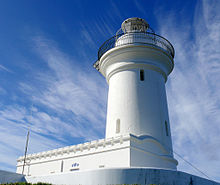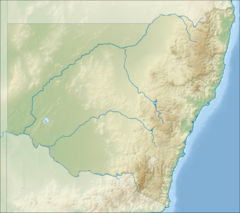South Solitary Island

South Solitary Island Light, 2009
|
|
|
New South Wales
|
|
| Location |
South Solitary Island New South Wales Australia |
|---|---|
| Coordinates | 30°12′24.33″S 153°16′2.52″E / 30.2067583°S 153.2673667°ECoordinates: 30°12′24.33″S 153°16′2.52″E / 30.2067583°S 153.2673667°E |
| Year first constructed | 1880 |
| Automated | 1975 |
| Construction | concrete tower |
| Tower shape | cylindrical tower with double balcony and lantern |
| Markings / pattern | white tower and lantern |
| Height | 66 feet (20 m) |
| Focal height | 190 feet (58 m) |
| Original lens | 1st order dioptric Fresnel lens |
| Light source | solar power |
| Intensity | 38,000 cd |
| Range | 15 nautical miles (28 km; 17 mi) |
| Characteristic | Fl.W. 5s |
| Admiralty number | K2812 |
| NGA number | 111-5976 |
| ARLHS number | AUS-152 |
| Managing agent | Australian Maritime Safety Authority |
South Solitary Island Light is an active lighthouse on South Solitary Island, an island within the Solitary Islands Marine Park, about 15 kilometres (9.3 mi) northeast of Coffs Harbour, New South Wales, Australia. The lighthouse is located at the summit of the island. It is considered the most isolated lighthouse on the New South Wales coast. It was first in New South Wales to use kerosene over colza oil, and the last to do so before converting to electric power.
Suggestions for a lighthouse near Coffs Harbour were made as early as 1856, with locations proposed on either North Solitary Island or South Solitary Island. It was the ship masters' preference that set the location to be South Solitary.
The lighthouse was designed by Colonial Architect James Barnet, and it is one of three concrete lighthouses built at that period, the others being Smoky Cape Lighthouse and Green Cape Lighthouse. Barnet had personally visited the island in October 1877 to determine the best locations for the buildings and the sources for materials. Cement and sand for the construction were transported to the island at harsh conditions, while broken stone was quarried on the island itself. Timber came in small vessels from Bellingen. Though construction was expected to finish by 1879, as the carving "18VR79" on the keystone over the entry doorway suggests, it was first exhibited on 18 March 1880.
The original lens was a Chance Bros. 1st order dioptric Fresnel lens, the second of its type to be used in Australia. It is currently at the Coffs Harbour Regional Museum, though the museum is currently in interim home due to water damage sustained during a storm in March 2009.
...
Wikipedia

